ST558_Project-2
Modeling the rental count of bikes _ Main code
Mu-Tien, Lee
- Require package
- Read in data
- Summarize the training data
- Training Model
- Predicting using the best tree-base model
- Predicting using the best boosted-tree model
Require package
#install.packages("")
library(knitr)
library(rmarkdown)
library(MuMIn)
library(tidyverse)
library(caret)
library(corrplot)
library(readxl)
library(caret)
library(ggiraphExtra)
library(knitr)
library(ggplot2)
library(ggpubr)
library(rpart.plot)
library(rpart)
library(DT)
Read in data
#read in hour data
HourData <- read.csv("hour.csv")
HourData<- HourData %>% select(-casual, -registered)
HourData$yr <- as.factor(HourData$yr)
HourData$holiday <- as.factor(HourData$holiday)
HourData$workingday <- as.factor(HourData$workingday)
#filter data by weekday
HourData <-HourData %>% filter(weekday==params$w)
#showing data
HourData <-HourData %>% select(-weekday, -workingday,-instant)
tbl_df(HourData)
## # A tibble: 2,487 x 12
## dteday season yr mnth hr holiday weathersit temp atemp hum
## <chr> <int> <fct> <int> <int> <fct> <int> <dbl> <dbl> <dbl>
## 1 2011-~ 1 0 1 0 0 2 0.2 0.197 0.64
## 2 2011-~ 1 0 1 1 0 2 0.2 0.197 0.69
## 3 2011-~ 1 0 1 2 0 2 0.2 0.197 0.69
## 4 2011-~ 1 0 1 4 0 2 0.2 0.212 0.69
## 5 2011-~ 1 0 1 5 0 3 0.22 0.273 0.55
## 6 2011-~ 1 0 1 6 0 2 0.2 0.258 0.69
## 7 2011-~ 1 0 1 7 0 1 0.2 0.212 0.69
## 8 2011-~ 1 0 1 8 0 1 0.2 0.197 0.51
## 9 2011-~ 1 0 1 9 0 1 0.2 0.182 0.47
## 10 2011-~ 1 0 1 10 0 1 0.22 0.197 0.37
## # ... with 2,477 more rows, and 2 more variables: windspeed <dbl>, cnt <int>
#Separate dataset into train (70%) and test (30%) data set
set.seed(1997)
train <- sample(1:nrow(HourData), size = nrow(HourData)*0.7)
test <- dplyr::setdiff(1:nrow(HourData), train)
HourDataTrain <- HourData[train, ]
HourDataTest <- HourData[test, ]
Summarize the training data
Here I will show you some summary of my training dataset.
1. I conduct a histogram of the rental count, since this is my response
variable.
2. I built up a summary table of all the weather measurement.
3. I also showing the weather summary via a boxplot.
4. I plot the rental count distributed by time.
5. I plot the rental count distributed by weather situation.
# plot the histogram of rental count
hist <- ggplot(data=HourDataTrain, aes(x=cnt))+geom_histogram(binwidth = 20, aes(color=yr))
hist <-hist+labs(title="Histogram of the retal count", x="rental count")
hist <-hist+scale_fill_discrete(labels=c(2011,2012))
hist
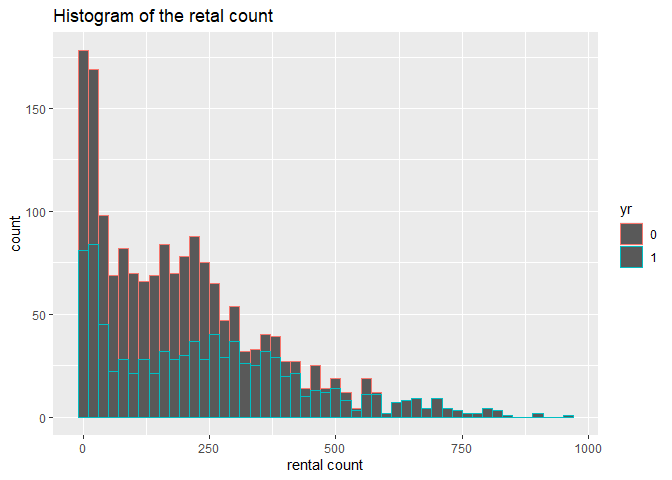
#prin out summary table for tempature humidity and windspeed
sum <- HourDataTrain%>% select(c(temp, atemp, hum, windspeed))
kable(apply(sum, 2,summary), caption="Numeric Summary for weather measurement")
| temp | atemp | hum | windspeed | |
|---|---|---|---|---|
| Min. | 0.0600000 | 0.0303000 | 0.0800000 | 0.000000 |
| 1st Qu. | 0.3400000 | 0.3182000 | 0.4600000 | 0.104500 |
| Median | 0.5000000 | 0.4848000 | 0.6100000 | 0.164200 |
| Mean | 0.4982184 | 0.4727968 | 0.6115805 | 0.185808 |
| 3rd Qu. | 0.6600000 | 0.6212000 | 0.7600000 | 0.253700 |
| Max. | 0.9600000 | 1.0000000 | 1.0000000 | 0.806000 |
Numeric Summary for weather measurement
#plot the boxplot of tempature humidity and windspeed (not genralized amount)
#plot base
boxplot <- ggplot(data = HourDataTrain, aes(x=season))
#adding 4 variables
tem <-boxplot+geom_boxplot(aes(y=temp*41, group=season))+labs(y="Tempature (c)", title = "boxplot for weather measurement")
fetem <-boxplot+geom_boxplot(aes(y=atemp*50, group=season))+labs(y="Feeling Tempature (c)")
hum <-boxplot+geom_boxplot(aes(y=hum*100, group=season))+labs(y="Humidity")
wind <-boxplot+geom_boxplot(aes(y=windspeed*67, group=season))+labs(y="Wind Speed")
#combine 4 plots into 1
ggarrange(tem, fetem, hum , wind, ncol = 2, nrow = 2)
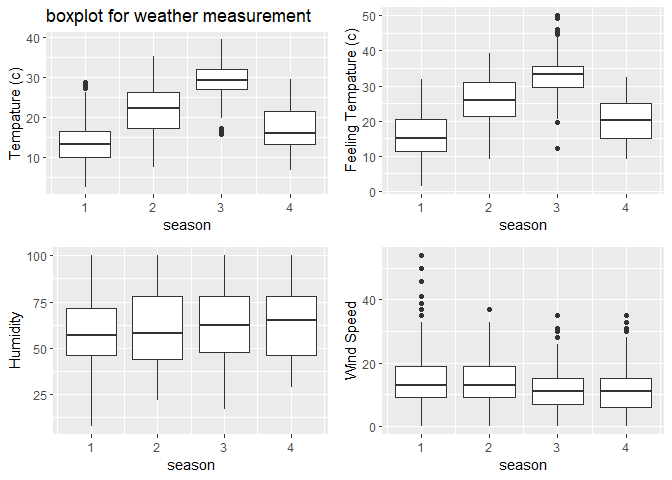
# plot the count distribution among time and weather
# by time
barplot1<-ggplot(data = HourDataTrain, aes(x=hr))+geom_col(aes(y=cnt, fill=yr))+facet_wrap(~mnth)
barplot1 <- barplot1+labs(x="time", y="Rental Count", title="Retal count distribution by month" )
barplot1+scale_fill_discrete(name="year", labels=c(2011,2012))
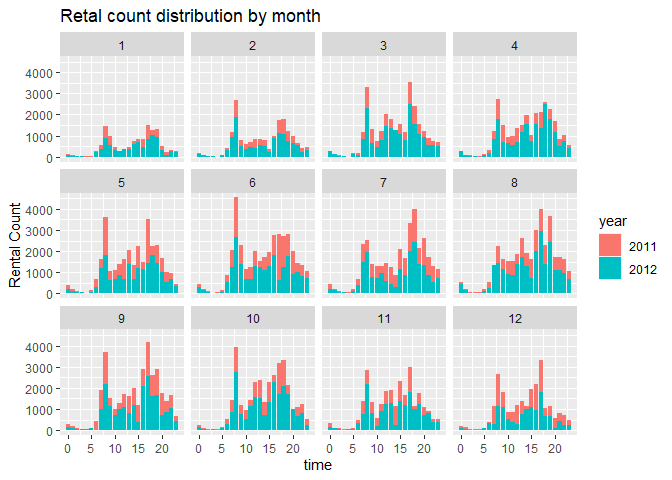
# by weather
barplot2 <-ggplot(data = HourDataTrain, aes(x=weathersit))+geom_col(aes(y=cnt, fill=yr))+facet_wrap(~mnth)
barplot2 <- barplot2+labs(x="Weather situation, 1: clear day, 2: misty day, 3:rain or snow", y="Rental Count", title="Retal count distribution by month" )
barplot2+scale_fill_discrete(name="year", labels=c(2011,2012))

Training Model
Here I use two different method to train my model. First method is using
a tree-based models with leave one out cross validation. For the second
method, I use the boosted tree model with cross validation. Both two
training are done using the train function from caret package. The
data was cantered and scaled before training.
Tree-based model
Since our respons variable is continuous. I use the regression tree
model to training my data. The method= "rpart" was used in train
function
Moreover, because I want to use the leave-one-out cross validation for
this training, therefore,the method= "LOOCV" was used in
trainControl.
We can adjust the grid parameter by ourselves. Since the default result
shows that cp should be very small to have a lowest RMSE. I set a
range [0.0001,0.0005] to fit for every weekday.
Something to notice, because the cp is too small, when I draw my
regression tree, it seems like a mess.
# set up training control, using leave one out cross validation.
set.seed(615)
trctrl <- trainControl(method = "LOOCV", number = 1)
# getModelInfo("rpart")
# training using regression tree models with cp in [0.0001,0.0005]
# since the cp seems have to be really small when I used the default cp to train
model1 <- cnt~season+yr+mnth+hr+holiday+weathersit+temp+atemp+hum+windspeed
RegTree_fit1 <- train(model1, data = HourDataTrain, method = "rpart",
trControl=trctrl,
preProcess = c("center", "scale"),
tuneGrid=expand.grid(cp=seq(0.0001,0.0005,0.00004))
)
# show the training result
RegTree_fit1
## CART
##
## 1740 samples
## 10 predictor
##
## Pre-processing: centered (10), scaled (10)
## Resampling: Leave-One-Out Cross-Validation
## Summary of sample sizes: 1739, 1739, 1739, 1739, 1739, 1739, ...
## Resampling results across tuning parameters:
##
## cp RMSE Rsquared MAE
## 0.00010 64.77218 0.8633108 38.55849
## 0.00014 64.76988 0.8633107 38.53232
## 0.00018 64.77336 0.8632758 38.51982
## 0.00022 64.97628 0.8623942 39.67933
## 0.00026 65.08888 0.8619641 39.65091
## 0.00030 65.30849 0.8610317 39.89369
## 0.00034 65.56521 0.8599220 40.28419
## 0.00038 65.81266 0.8588588 40.70583
## 0.00042 65.79123 0.8589248 40.45751
## 0.00046 65.93805 0.8583658 40.54614
## 0.00050 66.14625 0.8574950 40.86600
##
## RMSE was used to select the optimal model using the smallest value.
## The final value used for the model was cp = 0.00014.
# plot the RMSE of selected cp
plot(RegTree_fit1)
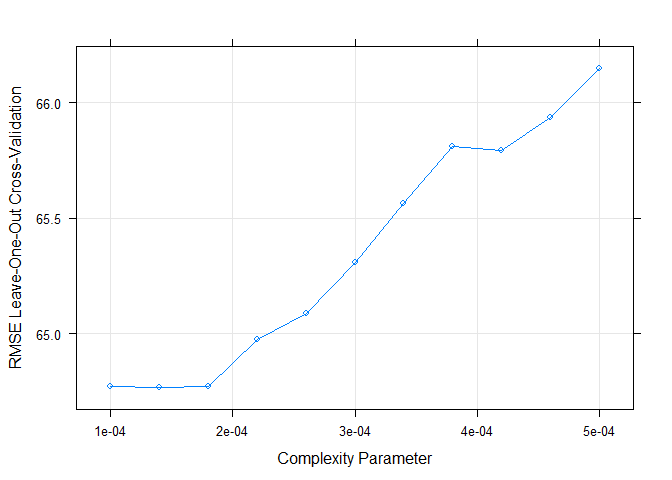
# plot my final tree model
rpart.plot(RegTree_fit1$finalModel)
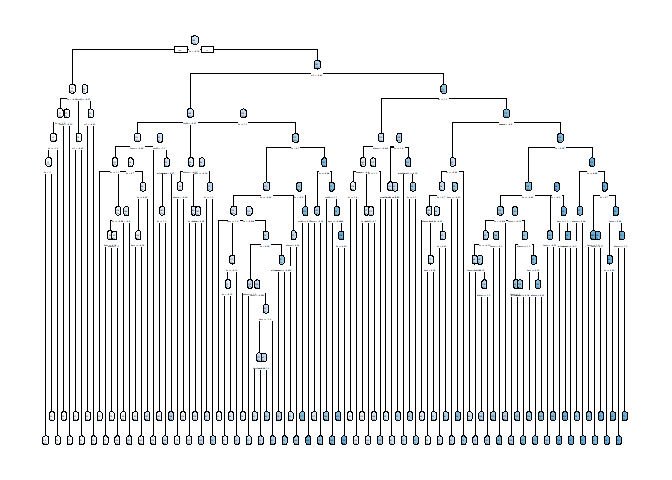
Boosted tree model
Here I want to training my data using boosted tree model. The method=
"gbm" was used in train function
Because I want to use thecross validation for this training,
therefore,the method= "cv" was used in trainControl.
We can adjust the grid parameter by ourselves. I set a range of number
of tree [100,1250] and interaction 5~11 to fit for every weekday.
# set up training control, using cross validation with 10 folder
set.seed(615)
trctrl <- trainControl(method = "cv", number = 10)
# training using boosted tree models with boosting interation in [700,1250] and try max tree depth 5~9
model2 <- cnt~season+yr+mnth+hr+holiday+weathersit+temp+atemp+hum+windspeed
RegTree_fit2 <- train(model2, data = HourDataTrain, method = "gbm",
trControl=trctrl,
preProcess = c("center", "scale"),
tuneGrid=expand.grid(n.trees=seq(100,1250,25),
interaction.depth=5:11,
shrinkage=0.1, n.minobsinnode=10)
)
# show the training result of boosted tree
RegTree_fit2$bestTune
## n.trees interaction.depth shrinkage n.minobsinnode
## 284 125 11 0.1 10
# plot the RMSE of different parameters
plot(RegTree_fit2)
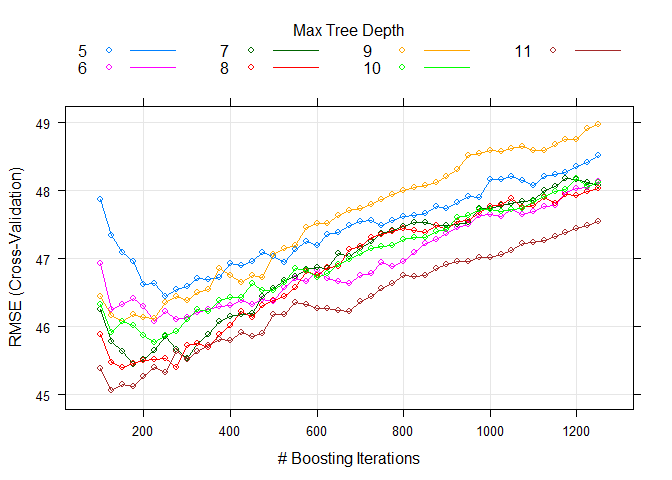
Predicting using the best tree-base model
Using the best boosted tree model to testing the data.
# predict use predict function
tree_pred <- predict(RegTree_fit1, newdata = HourDataTest)
#Calculate the Root MSE
RMSE_tree<- sqrt(mean((tree_pred-HourDataTest$cnt)^2))
label <- paste0("RMSE =", RMSE_tree)
# plot the prediction
count <- data.frame(true_count=HourDataTest$cnt,prediction=tree_pred )
predPlot <- ggplot(data=count, aes(x=true_count,y=prediction))
predPlot <- predPlot+labs(title="Prediction V.s. True Count using tree-base model")+geom_point()
predPlot <- predPlot+geom_smooth(color="orange")+geom_abline(aes(intercept=0,slope=1), color="blue")
predPlot <- predPlot+geom_text(x=200, y=600,label=label, color="brown")
predPlot
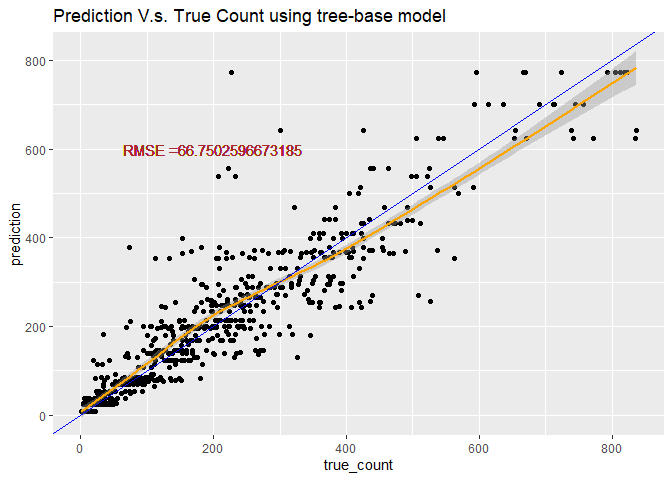
Predicting using the best boosted-tree model
# predict use predict function
boosted_pred <- predict(RegTree_fit2, newdata = HourDataTest)
#Calculate the Root MSE
RMSE_boosted <- sqrt(mean((boosted_pred-HourDataTest$cnt)^2))
lab <- paste0("RMSE =", RMSE_boosted)
# plot the prediction
count2 <- data.frame(True_count=HourDataTest$cnt,prediction=boosted_pred )
pred_plot <- ggplot(data=count2, aes(x=True_count,y=prediction))
pred_plot <- pred_plot+labs(title="Prediction V.s. True Count using boosted model")+geom_point()
pred_plot <- pred_plot+geom_smooth(color="orange")+geom_abline(aes(intercept=0,slope=1), color="blue")
pred_plot <- pred_plot+geom_text(x=200, y=600,label=lab, color=" brown")
pred_plot
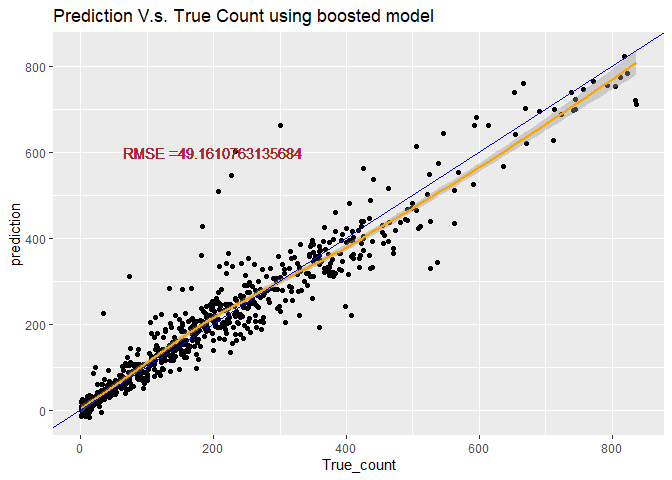
# create a linear model using repeated cross-validation
linear_mod <- train(cnt~season+yr+mnth+hr+holiday+weathersit+temp+atemp+hum+windspeed,
data=HourDataTrain,
method='lm',
preProcess=c("center", "scale"),
metric='RMSE',
tuneLength=10,
trControl=trainControl(method='repeatedcv', number=10, repeats=3)
)
# display the results of the linear model
summary(linear_mod)
##
## Call:
## lm(formula = .outcome ~ ., data = dat)
##
## Residuals:
## Min 1Q Median 3Q Max
## -358.66 -89.98 -27.69 53.87 602.77
##
## Coefficients:
## Estimate Std. Error t value Pr(>|t|)
## (Intercept) 198.1862 3.3160 59.766 < 2e-16 ***
## season 16.4403 5.8727 2.799 0.00518 **
## yr1 42.7597 3.3737 12.675 < 2e-16 ***
## mnth 6.1579 5.6341 1.093 0.27456
## hr 54.3184 3.6313 14.958 < 2e-16 ***
## holiday1 -1.7758 3.4014 -0.522 0.60169
## weathersit -0.2167 3.6530 -0.059 0.95270
## temp 51.0533 11.6545 4.381 1.25e-05 ***
## atemp -5.1047 11.5861 -0.441 0.65957
## hum -32.6591 4.1184 -7.930 3.90e-15 ***
## windspeed 3.3709 3.6887 0.914 0.36092
## ---
## Signif. codes: 0 '***' 0.001 '**' 0.01 '*' 0.05 '.' 0.1 ' ' 1
##
## Residual standard error: 138.3 on 1729 degrees of freedom
## Multiple R-squared: 0.3776, Adjusted R-squared: 0.374
## F-statistic: 104.9 on 10 and 1729 DF, p-value: < 2.2e-16
# compare our linear model to our test data
linear_pred <- predict(linear_mod, newdata=HourDataTest)
postResample(linear_pred, HourDataTest$cnt)
## RMSE Rsquared MAE
## 131.5847991 0.4165231 96.6972031